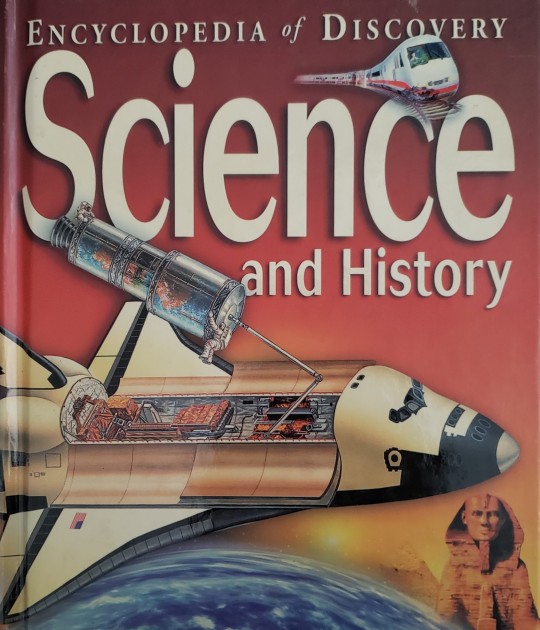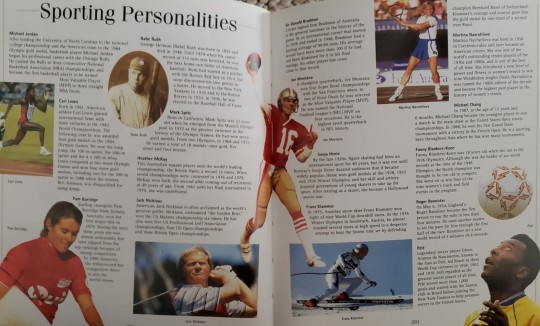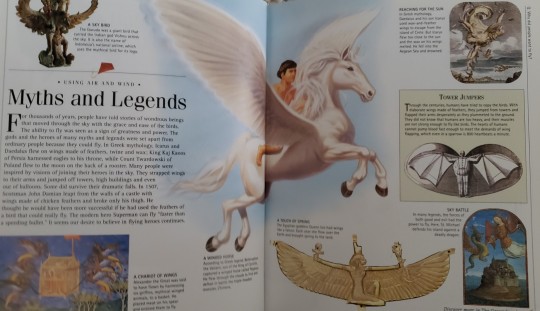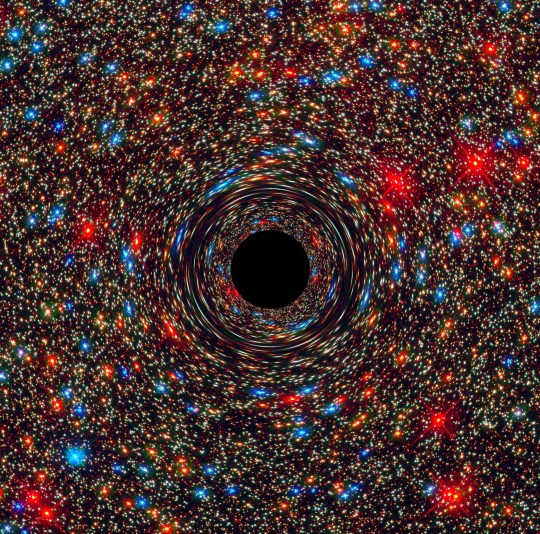#Science and History
Explore tagged Tumblr posts
Text
Captivating Student Video Captures the Evolution of Our World in Just 2 Minutes
Check out this remarkable video created by Joe Bush, a 19-year-old high school student from Minnesota, for his video production class project. Joe compiled hundreds of images sourced from across the internet to craft a 2-minute video that showcases the journey of our world—past, present, and future. Titled Our Story in 2 Minutes, the video takes viewers on a journey from the birth of the…

View On WordPress
#2-minute video#compelling video#digital storytelling#educational content#future of the planet#future predictions#history of the world#human development#Joe Bush#science and history#student video#timeline of Earth#universe evolution#visual storytelling#world timeline
2 notes
·
View notes
Text

Encyclopedia of Discovery: Science and History (2002)
Text: Claire Craig et al -- Art: Kylie Mulquin et al





#encyclopedia of discovery#science and history#2000s#00s#children's encyclopedia#claire craig#kylie mulqin#nonfiction#mythology#knights
2 notes
·
View notes
Text

#modern day#modern day slavery#slavery#African#mines#diamonds#diamond mines#real diamonds#science#disgusting#the upper class#rich people#Twitter#tweet#save the children#protect children#from corrupt higher ups#powerful people#evil#evil people#Africa#miners#stupid#society#culture#society and culture#history#poverty
19K notes
·
View notes
Text



Brazilian photographer Sebastião Salgado and his wife, Lélia Deluiz Wanick Salgado, have been instrumental in reforesting the Rio Doce Basin area in Brazil since 1998. Through their organization, Instituto Terra, they have planted over 2.7 million trees, successfully restoring more than 550 acres of forest and 2,000 natural springs. 
Their efforts have transformed a once barren landscape into a thriving forest ecosystem, demonstrating the profound impact that dedicated reforestation initiatives can have on environmental restoration.
23K notes
·
View notes
Text
Wrong: Ada Lovelace invented computer science and immediately tried to use it to cheat at gambling because she was Lord Byron's daughter.
Right: Ada Lovelace invented computer science and immediately tried to use it to cheat at gambling because that was the closest you could get in 1850 to being a Super Mario 64 speedrunner.
#history#computers#computer science#ada lovelace#memes#gaming#video games#super mario 64#speedrunning
70K notes
·
View notes
Text

Fall in New England 🍁
31K notes
·
View notes
Text
Love when I point out a problem with capitalism and people are like "oh so we should hate and shun technology and live like peasants" like living a good life is a sin we must atone to the God of Socialism by living in medieval villages. I say something like "climate change is bad" and they're like "then we must destroy all industry", I say something like "space exploration is good" and they're like "no only billionaries we must stay on earth", I say something like "electronics in the first world are artificially cheap by exploitation" and they literally, like right now, just said to me "have you heard of luddites they had good ideas".
It's never about dismantling current oppressive systems and building a better society, as socialism as the path to a communist society, it's always about getting punished. Because of your Sins.
You can teach Usamericans Marxism but you have to work triple time to unteach them Puritanism.
#cosas mias#I've learned my history of science I have nuance about this#but I really cannot abide for someone telling me that luddites had good ideas
9K notes
·
View notes
Text
was talking to my mom about how white people ignore the contributions of poc to academia and I found myself saying the words "I bet those idiots think Louis Pasteur was the first to discover germ theory"
which admittedly sounded pretentious as fuck but I'm just so angry that so few people know about the academic advancements during the golden age of Islam.
Islamic doctors were washing their hands and equipment when Europeans were still shoving dirty ass hands into bullet wounds. ancient Indians were describing tiny organisms worsening illness that could travel from person to person before Greece and Rome even started theorizing that some illnesses could be transmitted
also, not related to germ theory, but during the golden age of Islam, they developed an early version of surgery on the cornea. as in the fucking eye. and they were successful
and what have white people contributed exactly?
please go research the golden age of Islamic academia. so many of us wouldn't be alive today if not for their discoveries
people ask sometimes how I can be proud to be Muslim. this is just one of many reasons
some sources to get you started:
but keep in mind, it wasn't just science and medicine! we contributed to literature and philosophy and mathematics and political theory and more!
maybe show us some damn respect
21K notes
·
View notes
Text

Have you ever seen a giant worm? 👀🪱 While there are thousands of earthworm species known across the planet, only a handful are supersized. Members of the genus Martiodrilus can grow up to an incredible 4.9 ft (1.5 m) in length and weigh up to 1.1 lbs (0.5 kg)! Inhabiting underground burrows in parts of South America such as Colombia and Ecuador, these worms are rarely seen above ground—but can sometimes be heard as they move through the soil.
Photo: OWP / oliverpatrick, CC BY-NC 4.0, iNaturalist
5K notes
·
View notes
Text





More Stowaway AU
Pacifica dynamics with each Grunkle. Happy late Father’s Day and birthday to the grunks!
#Pacifica Northwest#Stanley Pines#Stanford Pines#Stan Pines#Gravity Falls#Stowaway AU#my art#doodles#there’s much more lovecraftian ass monsters and pirate specters than I’ve depicted I just really like making jokes about the dynamics#i love Paz and Stan beefing but like now it’s with love#Ford and Pacifica though that was a surprising discovery bc before I’d always have their relationship as positive neutral#maybe Paz a little tinyyyy bit scared of him bc he is Dipper coded but once he finds out about her paranormal connections he might#unintentionally treat her more science experiment and anomaly more than like a person which is very NOT a Dipper thing so Paz is freaked#but like in the Stowaway AU ok some of that happens but I think the more Ford gets to know her as a bullheaded but intelligent kid who’s#eager to impress he sees a bit of himself AND his brother within her personality and she’s had to go through so much shit but she’s still#here and talking her shit and she’s surprisingly interested in history and so intuitive and REALLY into paranormal shit like even if its not#all the cryptid and science shit he likes they find something to really bond over#and then everything else is just like hey! this kid is cool#and then in the middle of the night one day he’s like ‘Stanley I think I’m ready to be a father.’ and Stan goes BWUH?????
5K notes
·
View notes
Text
Seeing the Invisible Universe

This computer-simulated image shows a supermassive black hole at the core of a galaxy. The black region in the center represents the black hole’s event horizon, beyond which no light can escape the massive object’s gravitational grip. The black hole’s powerful gravity distorts space around it like a funhouse mirror. Light from background stars is stretched and smeared as it skims by the black hole. You might wonder — if this Tumblr post is about invisible things, what’s with all the pictures? Even though we can’t see these things with our eyes or even our telescopes, we can still learn about them by studying how they affect their surroundings. Then, we can use what we know to make visualizations that represent our understanding.
When you think of the invisible, you might first picture something fantastical like a magic Ring or Wonder Woman’s airplane, but invisible things surround us every day. Read on to learn about seven of our favorite invisible things in the universe!
1. Black Holes

This animation illustrates what happens when an unlucky star strays too close to a monster black hole. Gravitational forces create intense tides that break the star apart into a stream of gas. The trailing part of the stream escapes the system, while the leading part swings back around, surrounding the black hole with a disk of debris. A powerful jet can also form. This cataclysmic phenomenon is called a tidal disruption event.
You know ‘em, and we love ‘em. Black holes are balls of matter packed so tight that their gravity allows nothing — not even light — to escape. Most black holes form when heavy stars collapse under their own weight, crushing their mass to a theoretical singular point of infinite density.
Although they don’t reflect or emit light, we know black holes exist because they influence the environment around them — like tugging on star orbits. Black holes distort space-time, warping the path light travels through, so scientists can also identify black holes by noticing tiny changes in star brightness or position.
2. Dark Matter

A simulation of dark matter forming large-scale structure due to gravity.
What do you call something that doesn’t interact with light, has a gravitational pull, and outnumbers all the visible stuff in the universe by five times? Scientists went with “dark matter,” and they think it's the backbone of our universe’s large-scale structure. We don’t know what dark matter is — we just know it's nothing we already understand.
We know about dark matter because of its gravitational effects on galaxies and galaxy clusters — observations of how they move tell us there must be something there that we can’t see. Like black holes, we can also see light bend as dark matter’s mass warps space-time.
3. Dark Energy

Animation showing a graph of the universe’s expansion over time. While cosmic expansion slowed following the end of inflation, it began picking up the pace around 5 billion years ago. Scientists still aren’t sure why.
No one knows what dark energy is either — just that it’s pushing our universe to expand faster and faster. Some potential theories include an ever-present energy, a defect in the universe’s fabric, or a flaw in our understanding of gravity.
Scientists previously thought that all the universe’s mass would gravitationally attract, slowing its expansion over time. But when they noticed distant galaxies moving away from us faster than expected, researchers knew something was beating gravity on cosmic scales. After further investigation, scientists found traces of dark energy’s influence everywhere — from large-scale structure to the background radiation that permeates the universe.
4. Gravitational Waves

Two black holes orbit each other and generate space-time ripples called gravitational waves in this animation.
Like the ripples in a pond, the most extreme events in the universe — such as black hole mergers — send waves through the fabric of space-time. All moving masses can create gravitational waves, but they are usually so small and weak that we can only detect those caused by massive collisions. Even then they only cause infinitesimal changes in space-time by the time they reach us. Scientists use lasers, like the ground-based LIGO (Laser Interferometer Gravitational-Wave Observatory) to detect this precise change. They also watch pulsar timing, like cosmic clocks, to catch tiny timing differences caused by gravitational waves.
This animation shows gamma rays (magenta), the most energetic form of light, and elusive particles called neutrinos (gray) formed in the jet of an active galaxy far, far away. The emission traveled for about 4 billion years before reaching Earth. On Sept. 22, 2017, the IceCube Neutrino Observatory at the South Pole detected the arrival of a single high-energy neutrino. NASA’s Fermi Gamma-ray Space Telescope showed that the source was a black-hole-powered galaxy named TXS 0506+056, which at the time of the detection was producing the strongest gamma-ray activity Fermi had seen from it in a decade of observations.
5. Neutrinos

This animation shows gamma rays (magenta), the most energetic form of light, and elusive particles called neutrinos (gray) formed in the jet of an active galaxy far, far away. The emission traveled for about 4 billion years before reaching Earth. On Sept. 22, 2017, the IceCube Neutrino Observatory at the South Pole detected the arrival of a single high-energy neutrino. NASA’s Fermi Gamma-ray Space Telescope showed that the source was a black-hole-powered galaxy named TXS 0506+056, which at the time of the detection was producing the strongest gamma-ray activity Fermi had seen from it in a decade of observations.
Because only gravity and the weak force affect neutrinos, they don’t easily interact with other matter — hundreds of trillions of these tiny, uncharged particles pass through you every second! Neutrinos come from unstable atom decay all around us, from nuclear reactions in the Sun to exploding stars, black holes, and even bananas.
Scientists theoretically predicted neutrinos, but we know they actually exist because, like black holes, they sometimes influence their surroundings. The National Science Foundation’s IceCube Neutrino Observatory detects when neutrinos interact with other subatomic particles in ice via the weak force.
6. Cosmic Rays

This animation illustrates cosmic ray particles striking Earth's atmosphere and creating showers of particles.
Every day, trillions of cosmic rays pelt Earth’s atmosphere, careening in at nearly light-speed — mostly from outside our solar system. Magnetic fields knock these tiny charged particles around space until we can hardly tell where they came from, but we think high energy events like supernovae can accelerate them. Earth’s atmosphere and magnetic field protect us from cosmic rays, meaning few actually make it to the ground.
Though we don’t see the cosmic rays that make it to the ground, they tamper with equipment, showing up as radiation or as “bright” dots that come and go between pictures on some digital cameras. Cosmic rays can harm astronauts in space, so there are plenty of precautions to protect and monitor them.
7. (Most) Electromagnetic Radiation

The electromagnetic spectrum is the name we use when we talk about different types of light as a group. The parts of the electromagnetic spectrum, arranged from highest to lowest energy are: gamma rays, X-rays, ultraviolet light, visible light, infrared light, microwaves, and radio waves. All the parts of the electromagnetic spectrum are the same thing — radiation. Radiation is made up of a stream of photons — particles without mass that move in a wave pattern all at the same speed, the speed of light. Each photon contains a certain amount of energy.
The light that we see is a small slice of the electromagnetic spectrum, which spans many wavelengths. We frequently use different wavelengths of light — from radios to airport security scanners and telescopes.
Visible light makes it possible for many of us to perceive the universe every day, but this range of light is just 0.0035 percent of the entire spectrum. With this in mind, it seems that we live in a universe that’s more invisible than not! NASA missions like NASA's Fermi, James Webb, and Nancy Grace Roman space telescopes will continue to uncloak the cosmos and answer some of science’s most mysterious questions.
Make sure to follow us on Tumblr for your regular dose of space!
4K notes
·
View notes
Text

Boston 1721
5K notes
·
View notes
Text
The US military has done thousands of unconscionable things, each one more evil than the last, but on top of all of those things, on a minor but more spiteful level, I'll also never forgive them for what they did to Lithium
6K notes
·
View notes
Text
look, I know I've talked about this essay (?) before but like,
If you ever needed a good demonstration of the quote "Any sufficiently advanced technology is indistinguishable from magic", have I got an exercise for you.
Somebody made a small article explaining the basics of atomic theory but it's written in Anglish. Anglish is basically a made-up version of English where they remove any elements (words, prefixes, etc) that were originally borrowed from romance languages like french and latin, as well as greek and other foreign loanwords, keeping only those of germanic origin.
What happens is an english which is for the most part intelligible, but since a lot everyday english, and especially the scientific vocabulary, has has heavy latin and greek influence, they have to make up new words from the existing germanic-english vocabulary. For me it kind of reads super viking-ey.
Anyway when you read this article on atomic theory, in Anglish called Uncleftish Beholding, you get this text which kind of reads like a fantasy novel. Like in my mind it feels like it recontextualizes advanced scientific concepts to explain it to a viking audience from ancient times.
Even though you're familiar with the scientific ideas, because it bypasses the normal language we use for these concepts, you get a chance to examine these ideas as if you were a visitor from another civilization - and guess what, it does feel like it's about magic. It has a mythical quality to it, like it feels like a book about magic written during viking times. For me this has the same vibe as reading deep magic lore from a Robert Jordan book.
#off topic#literature#language#linguistics#science#science history#science fiction#fantasy#physics#atomic theory#anglish#chemistry#robert jordan#the wheel of time#uncleftish beholding
44K notes
·
View notes
Text

5K notes
·
View notes